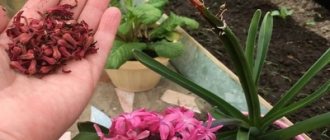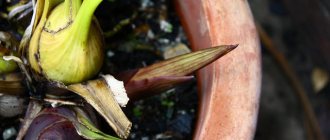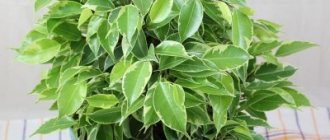There, a delicate flower grows in mountainous areas near waterfalls and reproduces by self-sowing.
But in indoor conditions, propagation of violets will require the participation of a grower.
Reproduction at home
There are several simple ways to propagate violets, which have long been used by gardeners. They are simple and very effective, vegetative propagation methods are especially popular:
- cuttings;
- children;
- dividing the bush.
The choice of a specific technique depends on the time of year and age of the mother specimen, its varietal characteristics . However, if the goal is to obtain a large number of young specimens, they resort to the generative method - sowing seeds.
Violet propagation by stepsons
Stepchildren are new shoots, daughter rosettes, that appear between the leaves of an adult violet. Usually they are simply removed so that they do not spoil the appearance of Saintpaulia. Then they often appear on their own.
Stepchildren are very convenient to use for propagation, including chimera violets.
Chimera violets do not reproduce with leaves. More precisely, children will also grow from the chimera’s leaf, but they will not repeat the mother plant. To obtain a “clone” similar to violets, they resort to the following method: the top of an adult plant is cut off (then it is rooted), after which stepsons begin to grow on the underparts.
Note!
Chimera violets also reproduce by flower stalks. But not all. There are leaf chimeras for which propagation by stepsons is the only way to preserve varietal qualities.
With the appeared stepson, do the following:
- The stepson of the violet is grown until it has three or four pairs of leaves.
- Carefully separate the new shoot from the mother plant. For these targets, use a toothpick or nail scissors.
- Place the stepson in the ground.
- Remove the pot for better rooting in the greenhouse.
- In a few months, the stepsons will become adult violets and bloom.
The process of propagation of violets by stepsons
Next is a video about the propagation of violets by stepsons:
General rules
To get healthy offspring, you should adhere to a number of important agrotechnical rules.
They concern not only the timing of reproduction, but also the creation of a favorable microclimate for the parent specimen and young violets . Therefore, in order to get an idea of how to propagate violets, you need to find out the main rules for caring for the plant.
What time of year is it best to propagate Saintpaulias?
Thanks to artificial lighting, cultivation of Saintpaulias is possible throughout the year.
But the optimal timing still occurs in spring and summer , when violets receive sufficient heat and light and are actively vegetating. In the fall, they are already preparing for a period of rest - rooting may not be successful.
Humidity level
Violet does well indoors. But the air should not be too dry. If the humidity is below 50-60%, it will be much more difficult to successfully propagate the flower.
Temperature
Intensive root formation occurs at a temperature of 26-28 °C. When the temperature drops below 20 °C, photosynthesis processes slow down, rooting occurs much more slowly, and the development of the vegetative mass is delayed.
Removing stepsons from violets.
18
I ordered it - I’m writing.
First, let's figure out what stepsons are. Stepchildren are another way of vegetative propagation of violets. These are the same small rosettes in the axils of the leaves. Many starters begin to grow stepsons before flowering. Miniatures are especially prone to this. Some varieties grow stepchildren in spite of everything and thereby delay flowering. I'm already tired of fighting with a couple of them. If they are not removed in time, the rosette will become ugly, crooked, and the leaves will bristle in different directions. Unless, of course, we are talking about trailers, stepsoning is normal for them. They should only be removed if they grow too densely. And that’s not all, just thin out a little. Stepchildren are also used when propagating chimera varieties, since their color is not transmitted by the leaf.
But with ordinary violets, no matter whether they are miniature or standard, it is better not to hesitate and remove the stepsons while they are still small. This will help keep the rosette nice and straight. Peduncles also grow from the axils of the leaves, like stepsons. This is what violet buds look like.
Be careful! Do not rush to immediately remove what appears in the sinuses. Especially if you have just started to get interested in violets. Some varieties have peduncles with rather large stipules (the leaves in the photo above are on the sides of the bud), sometimes at first they can be confused with a stepson. So wait a little until it becomes clear. The bud usually develops along with the stipules and will soon become visible. In stepchildren, as in children and adults, leaves grow in rows.
This is what stepsons look like
The most convenient way to remove them is with toothpicks or wooden skewers; I prefer a tool for removing cuticles; several times I came across eyebrow tweezers.
If you do not intend to preserve the stepson for subsequent reproduction, feel free to pry it under the base with a tool and remove it. (it’s most convenient to do this with the tool with the photo using one of the blades).
If you want to plant a stepson for reproduction, wait until it grows a little and its growth point is formed. Then it will not fall apart when separated and will have every chance of successful rooting. I didn’t have such a goal and this outlet was miraculously preserved in such an overgrown state, I forgot about it all the time. Therefore, I will show you the example of the largest stepson found on it. But I didn’t root it. Better grow them a little more, the one shown in the photo is too small!
It’s not noticeable in the photo, but even though he is so small, he already has a growth point. In the case of saving my stepson with this tool, it turned out to be most convenient for me to separate them. Carefully place the tool under the base of the rosette-stepson (the stem fits comfortably between the two blades) and carefully cut it off. It is also quite easy to do this with sharp tweezers. I haven't tried it with toothpicks. And this is what will come out as a result.
Let me remind you that if you keep your stepson, you should raise him before separation! You can also try to root this one (in case of problems with the mother plant. Here, usually everything comes into play and the sufferer is simply disassembled into parts - stepsons, leaves, heads. Something will take root)
For example, here are archival photos of my Precious Lavender variety. I bought it literally covered with stepsons of different sizes.
And here's what he looked like after the stepsons were removed.
And after 2 months.
And here are the stepsons themselves (When the photos were taken, I did not imagine that I would write about this. That’s why only these are available.)
Lately I have been rooting them in moist sphagnum moss. But you can do it right in the ground. To do this, fill a pot or glass (do not take a large volume, the future violet still needs to master the pot and until this happens, it can be accidentally filled with) with the mixture, carefully place the stepson in the center (if they are small, you can plant several). You can carefully secure it with toothpicks and straightened paper clips. And put it in the greenhouse. In a few weeks it will take root and begin to grow. (In the photo there is a stepson of a different variety, I gave these away. But it also took root in moss)
And in conclusion, for those who are going to do this for the first time and are afraid - it’s not so scary! Just like with dropping off children, the main thing here is to start. Even if you have a mini one =) The model for the blog was this little one.
Thank you for your attention! I hope that the article will be useful to you!
‹ How do you spend your time in the evenings? Violets for identification! ›
Which plants to choose
Propagation material is taken from violets of any age. However, for a young mother specimen such a procedure will be painful, while for older specimens there is already a small supply of nutrients for successful rooting. It is better to choose plants aged 2-3 years.
If the bush is old with a powerful root system, it can be propagated by dividing the bush. In addition, such specimens may already have formed lateral rosettes, which are also suitable for producing new plants.
You should avoid using young Saintpaulias as a mother plant , giving them the opportunity to build up root and vegetative masses and accumulate maximum vitality.
What soil to choose for young Uzambara violet
For successful growth, violets require a light and loose soil mixture with excellent breathability. The best option is a substrate based on high-moor peat with the addition of perlite, vermiculite or polystyrene foam.
As an alternative, take sphagnum moss or peat tablets; violet roots also develop very well in them . Peat tablets must be soaked before use as indicated in the instructions.
Pot or glass? What is better and how to correctly determine the right size
To root cuttings or parts of the stem, use cups with a diameter of 5-6 cm. There should be drainage holes at the bottom to drain excess water. It is permissible to use plastic cups and yogurt containers, making holes in them yourself.
When dividing a bush, take a container with a slightly larger diameter than the root system of the planting material.
If you use a container that is too large, the soil that has not been developed by the roots will begin to sour, become compacted, and will no longer allow air to pass through to the underground part of the violet.
In what cases are greenhouses and moss needed?
To stimulate rooting, greenhouses are used, regardless of the chosen propagation method. Their installation makes it possible to create an optimal microclimate for the development of the root system of young flowers.
Moss also speeds up the root formation process by maintaining a high level of soil moisture . In this case, there is no danger that the soil mixture will sour.
Note! Not all varieties of violets reproduce in this way. For example, “Raisin” and “Chimera” violets may not retain their varietal characteristics. And the varieties of violets “Dance of Galaxies” and “Ice Rose” will most likely be preserved.
Do leaves always give roots?
No, sometimes they rot without ever taking root.
100%
Always, 100% of leaves give roots
0%
I constantly struggle with leaves, roots appear on 2-3 out of 10
0%
Voted: 4
Removing stepsons on miniature violets.
Removing stepsons on miniature violets.
The process of violet pinching is natural and, sooner or later, almost inevitable. By the way, mini, semi-mini, and standards are also being sold, not to mention trailers.
Having a lot of miniatures and a few standards in my collection, I came to the conclusion that stepchildren on miniatures annoy me much more often than on standard varieties of violets, and it is simply necessary to talk about their removal, because this question is asked to me quite often, especially by novice violet lovers .
So, for a violet rosette to be symmetrical, it must have one head, i.e. One point of growth, of course, here we are not taking trailers, which have their own characteristics.
A stepson is a daughter rosette of a violet without roots, which is formed in the axils of the leaves of the mother rosette, sometimes at its base.
Growing stepsons take away the violet's strength to grow heads, as a result we have either a crooked rosette or a multi-headed tussock, the flowering time is delayed, and the flowering itself will no longer be so friendly and lush.
Now directly about the miniatures. Both children and adult plants take root; you need to regularly check them for stepchildren and remove any that appear.
What influences increased stepson formation? Firstly, varietal characteristics. I noticed that the most nimble violets, those that grow quickly and bloom early, usually form more stepsons. Then, excessively abundant fertilizing and rich, nutritious soil.
And finally, the stage of growing up.) Before the first flowering, most of the miniatures have stepsons, and often the massive appearance of stepsons tells me that the first flower stalks will soon appear. Stepchildren need to be mercilessly removed, but pay closer attention; sometimes tiny flower stalks already appear next to the stepchildren.
There is no need to be afraid that you will then have to constantly pick out the stepsons; in practice, after the first flowering, the rosettes will no longer be so much so, you will just need to remove single ones from time to time.
Finally, the process itself. ;)
A young rosette of the semi-miniature variety YAN-Katyusha is preparing for its first flowering.
Let's look under the leaves. I deliberately did not remove the stepsons for a long time to make it more clear. Usually, I remove smaller ones, since as the stepson grows, the likelihood of injuring the base of the leaf of the mother plant increases; the leaf may fall off, thereby disturbing the symmetry of the rosette.
I usually use a wooden skewer or toothpick as a removal tool.
I carefully move the leaves apart, pry up the stepson at the base and...Voila!
We repeat the procedure until all the stepsons are finished. As a result, we get axils without stepsons with peduncles left behind. Ready to bloom!!
Here's what we removed.
Not a single leaf was harmed during the removal process;)
I would like to add that stepchildren are not only an inevitable problem, but also an opportunity to get a new plant much faster than with leaf propagation, with a greater likelihood of repeating the properties of the mother one. In the case of chimeras and complex fantasy stories, stepchildren even become very valuable.
In this case, the variety is well transmitted by the leaf, but it would be a shame not to plant such fat stepsons;) The top two are quite suitable, the bottom one, damaged, is thrown away.
I label the cup, fill it with damp soil, slightly press the stepsons and into the greenhouse.
I want to show what can happen if you don’t remove stepsons from a variety prone to shoots. The Shino variety is beautiful, but stepsons are its strong point. For clarity, I did not remove them in time, I grew them a little. And here's the result :)
I decided to remove the stepsons simultaneously with the transplantation, and at the same time I tore off the lower curved leaves.
It’s ideal if you need to get a lot of kids of a given variety, but it’s still better not to let it get to this state. But if you succeed, then don’t be afraid, arm yourself with a convenient tool and go ahead!
Good luck in your fight against stepchildren, and I hope that my article will be useful to someone!
How to stimulate and speed up rooting
Two main techniques to speed up root formation still have the right to exist today. The first method involves the use of special drugs - growth stimulants . They are used to treat the cut site (in the case of propagation by leaf) or the roots of the division (in the case of propagation by dividing the bush).
The second way is to organize a mini-greenhouse . It is used as a film with a frame or a cut plastic bottle. Due to high humidity and temperature, root formation accelerates.
Recently, agrofibre has become popular; it can also be used to create a greenhouse environment. The canvas is much more durable than film, it is more durable.
Methods for propagating violets
There are a number of ways to propagate these plants, differing in complexity and technique.
They are represented by reproduction methods, which we indicate in the table.
| Reproduction method | Features of getting a new bush |
| Children | Children You can start when the fourth or fifth leaf is formed at a height of five centimeters. For replanting, it is necessary to prepare a pot with a drainage layer filled with special slightly acidic soil. When planting, it is important not to allow soil to get into the growing point of the flower, as this can lead to its death. |
| Leaf | It is used when there is a small amount of planting material, if the violet is a rare variety. With this method, the leaf stalk is cut off completely, the cut is allowed to dry completely, after which it is treated with activated carbon. When planting, it is important that the cut fits tightly to the ground. It is better to plant in special moss (sphagnum), which can retain moisture and disinfect |
| Stepchildren | The side rosettes, which are formed in the side sinuses surrounding the main rosette, are cut off. The rooting process is similar to leaf |
| Seeds | First of all, a pair of violets is selected as parents with the necessary characteristics. Both flowers should bloom profusely and be healthy. During the flowering process, it is necessary to collect pollen from one violet and pollinate the flowers of another with it, in order to obtain ripe seed boxes after four months. Seeds should be planted in moist soil with plenty of perlite. When planting, the seed must be mixed with sand. After this, it is recommended to place the container with seedlings under special lamps and cover it with glass. It is important to prevent drying out and carry out systematic watering with a spray bottle. When seedlings grow to half a centimeter in diameter, it is recommended to transplant them and then grow them as seedlings |
| Peduncles | The simplest, but requires patience and accuracy |
When planting violets, it is important to be extremely careful.
These capricious plants require special attention and caution, but they will thank you a hundredfold for your love and patience.
How to use cytokinin paste when propagating Saintpaulia
The product is used to produce babies from cuttings. The paste is applied with a needle into a scratch made on the petiole near the surface of the earth in a glass. Literally after 10-14 days, intensive formation of children begins , which must be placed in a timely manner.
How to care for older children
Aftercare is quite simple. It comes down to simple steps:
- Watering - abundant moisture is required only for the first time. Then they make sure that the earthen ball does not dry out. The optimal method of watering is bottom (from a tray). The main thing is to prevent drops from getting on the leaves.
- Feeding - during the active growing season, feed with liquid complex fertilizers for flowering crops in half the dosage. Frequency of use: every decade.
- Protection from diseases and pests - violets have strong immunity. It is important not to over-moisten the soil, which can lead to the development of gray rot. The roots begin to rot, and over time the violet dies. Dry air is also dangerous, causing spider mites to colonize shoots. To combat the latter, insecticidal preparations are used.
- Transplantation - young plants are transplanted into slightly larger containers every spring to ensure lush flowering.
Is it possible to grow Saintpaulias on a windowsill?
At home, violets are grown on windowsills. For the successful growth and development of young violets, it is enough to provide a good level of lighting: in winter, containers are placed near windows with a southern orientation, and in other periods - eastern or western .
To prevent young violets from being hot or cold, they are placed in mini-greenhouses where a stable temperature and humidity regime is maintained. The windows near the flower are not opened for ventilation to avoid drafts.
After successful rooting, the greenhouse is removed, and apartment conditions are suitable for adult plants (humidity - 50%, temperature - 22 °C).
What methods to use for varietal Saintpaulias
The seed propagation method is not only a labor-intensive process: even after successful artificial pollination, the formation of seed pods and the collection of seed material, the method will not give the expected results when growing varietal flowers. The resulting seedlings do not retain the varietal characteristics of the parent specimen.
This can be avoided by using vegetative techniques. Any method is suitable, from cuttings, propagation by rosettes and to dividing the bush. The exception is the chimera violet. In this case, the apical propagation method is used.
Propagation of violets by peduncles
This method is used, as a rule, for chimera violets, which do not transmit their varietal characteristics when propagated by leaves.
The sequence for growing violets from a peduncle is as follows:
- Choose strong peduncles with flowers of the correct varietal color. They are cut from the plant, flowers and buds are trimmed. Then the stem of the peduncle is shortened with a scalpel or blade, leaving 1-1.5 cm.
- Peduncles are rooted in soil or moss; the substrate must be filled to the level of the stipules.
- Over time, stipules develop stepchildren. They are raised and then separated like ordinary children.
- However, it is worth considering that this is a matter for the patient: many plantings die, and such reproduction takes time.
Propagation of violets by peduncles
They will tell you how to propagate violets with peduncle support in the video:
Advice from experienced flower growers
Propagation of violets is a painstaking but fascinating process. If you follow all the rules, the florist can easily preserve the varietal qualities, receiving many young, lushly blooming violets.
Are you looking for an answer to the question why violets don’t bloom? Perhaps they are affected by some kind of disease or pests are bothering them.











